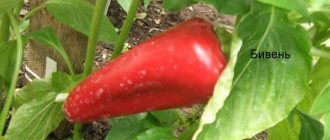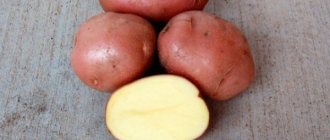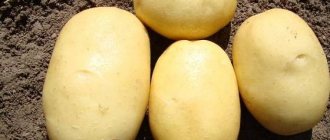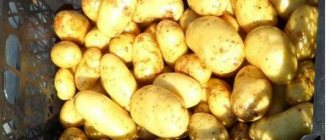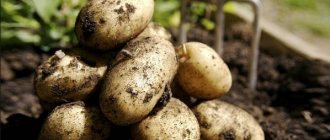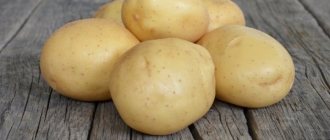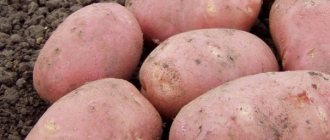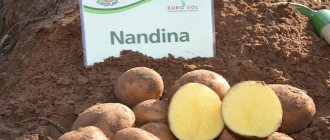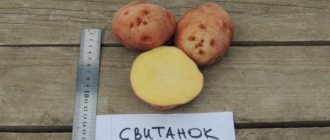Vegetable growing » Potatoes
0
1346
Article rating
Kira Stoletova
Blue Danube potatoes have gained enormous popularity around the world in just a few years. Thanks to the fact that breeders took care of its immunity, it can be grown for organic products. Moreover, this type of root crop is resistant to long-term transportation and can be stored for a long time in the right conditions.
Description of Blue Danube potatoes
The history of the origin of the Blue Danube potato variety
The Blue Danube variety was developed by German breeders at the beginning of the 21st century. To create it, we used the Sarpo Mira potato variety, which is highly resistant to a large number of diseases.
Officially registered in the State Register of Russia in 2005.
The table presents data on the mass of marketable tubers (grams) of different varieties:
| Name | Variety | Weight |
| Nikulinsky | Late ripening | From 70 to 120 |
| Cardinal | Late ripening | 65-110 |
| Rocco | Late ripening | 100-120 |
| Picasso | Late ripening | 80-140 |
| Borovichok | Early ripening | 120-200 |
| Elmundo | Early ripening | 120 |
| Felox | Early ripening | From 100 to 120 |
| Bellarosa | Early ripening | From 120 to 210 |
| Karatop | Extra early | From 58 to 100 |
| Zhukovsky early | Extra early | 100 to 120 |
| Farmer | Extra early | From 90 to 110 |
| Minerva | Extra early | From 120 to 245 |
| Sorcerer | Mid-late | From 75 to 120 |
| Mozart | Mid-late | From 100 to 150 |
| Grenada | Mid-late | From 800 to 100 |
| Melody | Mid-late | From 95 to 180 |
| Giant | Mid-early | 100-140 |
| Tuscany | Mid-early | From 90 to 125 |
| Purple Haze | Mid-early | From 90 to 160 |
| Openwork | Mid-early | 90-120 |
Description of the variety
Roots:
- Tubers are oval-oblong;
- Dense peel of blue-violet color;
- Medium-sized eyes;
- The pulp is white when cut;
REFERENCE: Landing is carried out from north to south. The plants will be evenly illuminated by the sun, which promotes rapid growth.
- Starch content from 13 to 16%;
- Average weight varies from 100 to 200 grams;
- The harvest from one bush is from 8 to 12 tubers.
Bushes:
- The plant is erect, medium in size, with a rigid stem, heavily leafy;
- The leaves are green;
- Yellow flowers;
- Purple corolla.
Colored potatoes:
Main features of the variety
Potatoes with purple tubers are a wild crop from South America. In the European part, there was no planting of this species for a long time. Modern scientists have carried out work on the selection of American game and familiar potato varieties.
Please note! No genetic modification methods were used in the production of new purple varieties. Exclusively classical selection options were used.
General distinctive features of potatoes with unusual colors:
- oblong clunies;
- useful components included in the composition help improve immunity;
- good preservation rates due to the dense peel;
- The purple tint of the pulp remains even after cooking.
The culture is distinguished by its characteristic nutty taste after processing.
History of appearance
The purple tuber crop first appeared in North America in the Andes Mountains as a wild crop. Thanks to the work of breeders, this variety is grown in Europe.
People made the first attempts to grow purple root vegetables in Siberia. The result was achieved only in 2011 in Tomsk. The seed material used was brought from Korea.
Many varieties of purple potatoes have been developed. They differ from each other in the intensity of color.
Characteristics of tubers
Purple root vegetables are distinguished because of their special taste. Many of the varieties have a nutty flavor, especially when cooked. This circumstance gives the dishes piquancy and unusualness.
The tubers of the purple variety have an exotic color both outside and inside. Shade may vary. There are varieties that have soft purple, pink, lilac flesh.
Distinctive features:
- pulp structure with average starch content (about 13%);
- the composition contains proteins, iodine, vitamins and various beneficial substances;
- thick, dense peel;
- depending on the variety, the length of the potato can reach 10 cm;
- the average weight of root vegetables is 50-200 g;
- after heat treatment the potatoes are crumbly;
- the pulp can be colored completely or partially.
Almost all species are characterized by an oblong shape.
Top appearance
The first shoots may be of an incomprehensible color, but gradually they level out and become a normal green color. The trunks are thick, dense, healthy foliage is bright green. The tops quickly unfold and survive the neighbors' garden beds.
Flowering is abundant, inflorescences are large. Flowers differ depending on the variety. May be white, purple, pink.
Beneficial features
Purple root vegetables even have healing properties. Regular consumption of purple potatoes will help reduce blood pressure. But hypotensive people (low blood pressure) should not overuse the vegetable.
The pulp contains antioxidants that help slow down the aging process of the body. For older people, purple potatoes should be a frequent dish.
Root vegetables contain vitamins C and E, which are very beneficial for the body. There are also special carotenoids responsible for the synthesis of vitamin A. Thanks to frequent consumption of vegetables, they maintain optimal water balance. Ensure proper functioning of the endocrine system.
Eating purple potatoes is beneficial for diabetics. Special components (anthocyanins), which provide the original color of the tubers, prevent the formation of cataracts in diabetes mellitus. They also help control blood sugar levels.
Benefits of eating purple root vegetables:
- strengthening blood vessels;
- decreased blood pressure;
- contains less starch;
- blood sugar levels decrease;
- the likelihood of developing oncology and atherosclerosis is reduced;
- immunity increases.
Purple root vegetables are classified as dietary products. When dieting, it is recommended to eat it baked.
Contraindications and disadvantages
Like any crop, purple potatoes have their disadvantages:
- thick peel;
- with a large amount of moisture, the development of rotting processes is possible;
- To obtain a good harvest, fertile soil and regular fertilization are necessary;
- there are a number of contraindications.
There are no specific contraindications for eating purple root vegetables, but there are a number of restrictions. Do not abuse this product if:
- terminal obesity;
- individual intolerance;
- constipation;
- low blood pressure;
- low level of stomach acidity.
If you consume purple potatoes under restrictions, you may experience an exacerbation of diseases, flatulence, constipation, and bloating. With individual intolerance, an allergy occurs.
Advantages and disadvantages
Potatoes of the Blue Danube variety have the following main advantages:
- Resistant to mechanical damage and cracking;
- High taste characteristics;
- Abundant and stable harvest;
- During proper storage, it does not deteriorate and does not sprout for a long period;
- The presence of great germ potential;
- The ability to grow and produce high-quality harvests even on depleted soil;
- Excellent immunity to most dangerous diseases.
No deficiencies have been identified in Blue Danube potatoes.
Correct fit
Basic rules for planting varieties:
- The area for growing potatoes should be sunny, without stagnant water;
- Medium-sized specimens, without damage, with many strong sprouts, are selected as seed material;
- After selecting the planting material, treatment is carried out using a growth stimulator, as well as disinfectants;
- Tubers are planted in soil heated to +12 °C. A distance of 20 cm is maintained between the bushes, the row spacing should be at least 50 cm. Planting material is buried 12 cm.
Landing dates and rules
Potato yield depends on the planting date. Agronomists warn amateur gardeners against planting too early; there is also no point in delaying it. Typically this period occurs at the end of April - beginning of May. The earth should be warmed up to eight to ten degrees, at this temperature the tubers begin to grow. There is no point in planting them in cold soil; they will simply lie there uselessly.
Article on the topic: Potato variety “Debryansk” - description and photo
Potato planting material should be the size of a chicken egg or slightly smaller. Tubers must be germinated before planting. This will make it possible to discard unsuitable planting material: tubers with thin thread-like shoots, as well as those on which small nodules have formed.
The rules for planting colored Blue Danube potatoes are the same as for light ones. Before planting, it is advisable to soak the potatoes in a solution of boric acid to protect the plants from fungal diseases that pose a danger to this particular variety.
When planting potatoes in order to obtain seed material, the distance between bushes in a row should be 20 cm. Commercial potatoes should be planted every 30 cm, the distance between rows should be 70 cm.
Colored potatoes need watering. “Blue Danube” under normal weather conditions should be watered at least three times; if the summer turns out to be dry, the number of waterings should be doubled. The main condition is that watering is not excessive, as this negatively affects the safety of the tubers. Potatoes need to be hilled and weeds destroyed in time.
Care
In the future, caring for potato plantings consists of the following activities:
- Potatoes need regular watering;
REFERENCE: Watering is carried out in the evening hours, this will not allow the water on the leaves to dry out until the morning.
- Loosen the soil in a timely manner, especially after watering and precipitation, to prevent the formation of a crust on the surface of the earth;
- Hill up the plantings twice a season;
- Mulch the soil;
- Apply fertilizers.
We invite you to familiarize yourself with potato varieties that have different ripening periods:
| Late ripening | Early ripening | Very early | Mid-late | Mid-early |
| Nikulinsky | Borovichok | Forty days | Crane | Yanka |
| Cardinal | Elmundo | Karatop | Sorcerer | Giant |
| Rocco | Felox | Riviera | Mozart | Tuscany |
| Kiwi | Bellarosa | Zhukovsky early | Grenada | Purple Haze |
| Ivan da Marya | Natasha | Farmer | Melody | Openwork |
| Picasso | Ariel | Minerva | Margarita | Santana |
| Asterix | Queen Anne | Veneta | Ramona | Desiree |
| Slav | Arosa | Kiranda | Dolphin | Lady Claire |
Features of planting and growing
When cultivating this vegetable, it is recommended to take into account some nuances. The culture is demanding to care for and requires patience and certain skills.
Preparing for landing
Tubers begin to be prepared 1.5 months before planting. They are transferred from storage to a warmer place and laid out in one layer.
When the sprouts reach 2 cm, the potatoes are brought out into the light so that the sprouts do not stretch too much.
Soil requirements
The yield and taste of vegetables depend on the composition of the soil. The most unsuitable soil for purple potatoes is loam, the most favorable is light and fertile, saturated with air. The vegetable does not tolerate drought well, but stagnation of water must also be avoided.
Before planting, the soil is dug up twice: in the fall, before the first frost, and in the spring, immediately before planting. If the soil is too hard, add river sand.
Dates, scheme and rules of planting
The vegetable is planted in the spring, when the soil warms up to +5...+7°C, since the plant does not tolerate late spring frosts.
Holes about 10 cm deep are made in the dug up soil, and wood ash is added for disinfection. The holes are made according to a 35x60 cm pattern to provide enough space for rooting and formation of bushes. Potatoes are planted in the prepared holes using one of the selected methods.
Features of cultivation
Growing purple potatoes is no different from cultivating regular varieties.
There are two planting methods:
- traditional eyed;
- seedling
With the eye method, the prepared seed material is buried in the holes, sprinkled with wood ash. The first shoots usually appear 10–14 days after planting.
In the second option, the seeds are sown at home for seedlings. After this, the finished sprouts are transferred to a permanent place. Replanting begins in May, when the soil warms up to +5...+7°C.
Nuances of care
To successfully cultivate purple potatoes and obtain a rich harvest, you need to feed the plants, water and weed in a timely manner.
Watering mode
Caring for plants involves constant monitoring of soil moisture. If there has been no precipitation for 10–15 days, the seedlings are watered with warm water
Irrigation is especially important during budding and after flowering. It is necessary to avoid stagnation of water in the soil
When an earthen crust forms, it is thoroughly loosened.
Top dressing
Purple potato varieties require periodic feeding: during budding and after flowering. Organic and potassium fertilizers are used. Before planting, it is advisable to add humus at the rate of 0.5 kg per 1 m2.
Weeding and hilling
The first hilling is carried out after the appearance of friendly shoots. This will protect young bushes from return frosts and retain moisture. The procedure is repeated when the plants reach a height of 30–35 cm.
Weeding is carried out several times during the summer as needed.
Disease and pest control
Many varieties are resistant to major potato diseases, but precautions are never superfluous
It is important to change the planting location, alternating crops on the site with legumes and cruciferous vegetables. For potato diseases, use Bordeaux mixture, copper sulfate, Kuprikol, Kurzat R (preparations based on copper salts), Ditan M-45 (active ingredient - mancozeb), Shirlan, Thanos
For potato diseases, Bordeaux mixture, copper sulfate, Kuprikol, Kurzat R (preparations based on copper salts), Ditan M-45 (active ingredient - mancozeb), Shirlan, Thanos are used.
Colorado beetles and click beetles are the main enemies of the crop. They spoil the tops and appearance of tubers, reduce productivity and negatively affect the shelf life of vegetables. Pests are eliminated using insecticides.
Diseases and pests
All potato growers grow the Blue Danube variety. Potatoes are popular due to the variety's immunity to diseases, which makes it possible to do without the use of chemicals.
ATTENTION: To ensure a uniform supply of nutrients to the root crops, the plant stems are broken at a distance of 15-20 cm from the surface of the ground. This will slow down growth and development after flowering.
"Blue Danube" has excellent immunity to almost all diseases, such as:
- Blackleg;
- Lumpy, black and powdery scab;
- Dry rot of tubers;
- Curling of leaves;
- Some types of nematodes;
- Anthracnose.
Reviews about the variety
Most even novice gardeners with little experience know that the potato variety needs to be replaced every 3-4 years. That is why experts recommend growing elite seed material. Thanks to only positive reviews from gardeners, Blue Danube potatoes are currently in great demand in household plots.
The Blue Danube potato is appreciated by gardeners all over the world for its resistance to diseases and pests. Because of its high-quality yield, the Blue Danube variety is grown for sale. It is easy to care for, but do not forget about timely hilling and watering to obtain the desired harvest.
ᐉ Potatoes
Vegetable growing » Potatoes
0
1275
articles
Kira Stoletova
Blue Danube potatoes have gained enormous popularity around the world in just a few years. Thanks to the fact that breeders took care of its immunity, it can be grown for organic products. Moreover, this type of root crop is resistant to long-term transportation and can be stored for a long time in the right conditions.
Description of Blue Danube potatoes
How to cook it correctly?
Today, purple potatoes are still considered a delicacy and not available to everyone. Therefore, well-founded doubts arise about its preparation.
In the world of haute cuisine, on the contrary, this vegetable has been around for a long time and does not surprise anyone.
Many famous chefs have long used it to prepare their masterpieces and are happy to share their experience of preparing this wonderful root vegetable.
We suggest you read: Is it possible to store potatoes affected by beetleworm?
Famous TV cook Hector Jimenez Bravo recommends baking purple potatoes. To do this, you need to select small tubers, wash them thoroughly, make punctures with a fork in several places, rub the potatoes with olive oil and place them on a baking sheet. It should be baked in an oven preheated to 200 degrees for 40 minutes to 1 hour.
The finished potatoes need to be cut into halves and some of the pulp should be selected from the middle so as to form boats. The selected pulp needs to be ground into puree, add chopped cheese, ham and herbs, mix everything. Place the resulting mass into prepared boats, place a small piece of butter on top and bake for another 10 minutes.
The most famous modern cook, Gordon Ramsay, advises using purple potatoes to make salads. To do this, you need to boil the potatoes in their jackets.
To ensure that the color of the product remains unchanged during the cooking process, it must be boiled only in salted water and for no more than 20 minutes.
You can combine such potatoes with cheese, fish, meat, sausages, smoked meats; legumes complement it wonderfully.
Jamie Oliver recommends using fillet potatoes for cold appetizers. In addition to potatoes, such a dish may include boiled chickpeas and twill beans, cherry tomatoes, herbs, and garlic.
Source: https://yarty11.ru/vidy-tomatov/kartofel-goluboj-dunaj-kupit.html
